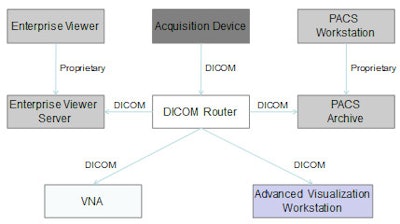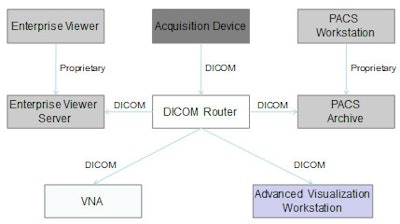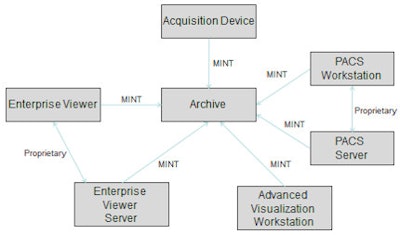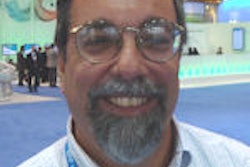
For all its achievements in facilitating interoperability between imaging equipment, the DICOM standard can be a slow way to communicate medical images in the real world. But a new initiative called the Medical Imaging Network Transport (MINT) hopes to speed up the process.
Developed by an ad-hoc group currently consisting of vendor representatives and academic researchers, the open-source MINT protocol employs Web technologies such as hypertext transfer protocol (HTTP) and extensible markup language (XML) to improve on current methods for communicating and storing DICOM image objects. The developers believe that MINT could eliminate the need for DICOM routing and application-specific caches, improving PACS performance and reliability, as well as lowering costs.
The need for improved image transfer speed continues to be a prominent issue in today's world of ever-increasing imaging study sizes. At Johns Hopkins University, for example, radiologists spend a fair amount of time waiting for large studies to download to their workstations, said James Philbin, PhD, a MINT group member and director of the Center for Biomedical Imaging and Informatics.
The institution also has around 12 different miniPACS networks, each with its own cache (for a total of around 100 TB worth of caches), Philbin said.
"We believe with a protocol like MINT we can eliminate those caches, and we'd also be able to run [those] miniPACS in virtual machines, all of which will lower operating and infrastructure expenses," he said.
Web technologies
MINT utilizes the existing DICOM data model but applies different encoding and transmission protocols for communication and storage. The use of Web technologies confers scalability and speed benefits, said Christopher Hafey, a MINT group member and chief architect at advanced visualization firm Vital Images.
"We want to leverage that knowledge in the technology space, in the IT management space, and apply that to DICOM so we can get the same kind of scalability and performance rather than reinvent the wheel ourselves," Hafey said.
MINT is based on representational state transfer (REST) software architecture, which enables any Web browser to access data from a MINT server and perform tasks such as searching for studies and accessing image information and attributes, he said.
"The power of that is that everybody has a Web browser," Hafey said. "Think about being able to talk to your PACS archive and do things like [DICOM] C-Find and C-Store against that archive, all through your Web browser," Hafey said. "It's a very powerful idea. Once you kind of unhook the medical imaging domain from the DICOM transport protocol [using] Web technologies, you can take advantage of all of these other tools and programming languages and techniques that have built the Web into what it is today and apply that to the medical imaging domain."
In addition to facilitating searches, MINT would also provide access to a changelog interface that informs users about changes to the MINT server, such as if a study was added or if images were added or deleted.
MINT can access study metadata -- which includes information such as the study accession number and the patient number -- independently of the pixel data (the image itself). Separating the metadata from the pixel data allows viewers to stream data on demand so users can find out what's in a study and start pulling over images or ranges of images in a separate request to provide an optimum viewing experience, Hafey said.
Getting the metadata first also allows viewers to quickly create a hanging protocol while the rest of the image data are streamed in, according to Philbin.
"It also gives the person in front of the viewer a much better viewing experience," he said.
By providing a new standard interface to access archives, the need to perform data migration also could be avoided, Philbin said.
"Today, if you decide to change PACS vendors, you have to migrate your whole archive from one vendor to the other," he said. "[MINT] would let you avoid migrating; you would just reindex the archive."
 All images courtesy of MINT.
All images courtesy of MINT.MINT doesn't change any information in the DICOM data structures; it's just a way to encapsulate DICOM standard data in a normalized format, Philbin said.
"We're not trying to change DICOM so much as change the way it is sent over the network and stored," he said. "We're not changing any of the underlying representations."
Since MINT doesn't affect the DICOM information model itself, future changes to the standard will not affect implementation, Hafey said.
"You won't have to do additional work to 'MINT-ify' [those additions]," he said.

A work-item has been submitted to the DICOM committee to turn MINT into a DICOM standard, said Philbin, who is also co-chair of DICOM WG-27 (Web Technology for DICOM).
If added to DICOM, MINT would also likely be adopted by the Integrating the Healthcare Enterprise (IHE) initiative in the future, Hafey said.
"IHE embraces DICOM, so we would expect that IHE would embrace this new MINT-based supplement as part of an IHE profile of some type," he said.
Vendors could choose to adopt MINT in different ways. An archive vendor, for example, could take the MINT reference implementation and integrate it with its own source code. Other vendors may analyze MINT and reimplement it with their own storage infrastructure, Hafey said.
"We will have to see more products come to market and see how they integrate it with their system," he said. "There are different ways of doing it."
Integration into existing image viewing software should be an easy task, Hafey said.
MINT was recently demonstrated by DeJarnette Research Systems in its booth at the 2010 RSNA meeting in Chicago.
Down the road, the group would also like to see modality vendors adopt MINT, Philbin said.
"We think it'll be a much better way to send data from modalities to vendor-neutral archives or miniPACS," he said. "We think this will make all parts of medical imaging significantly better than they are today."
More information on MINT can be found here.



















